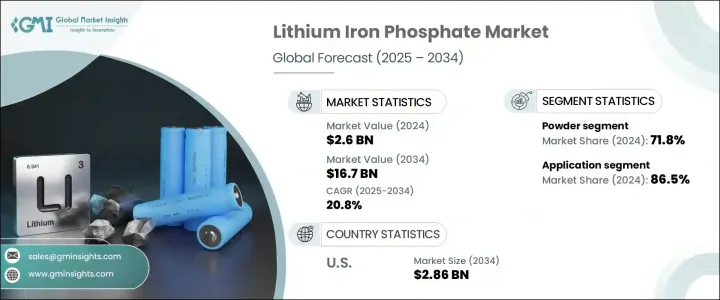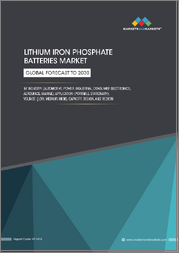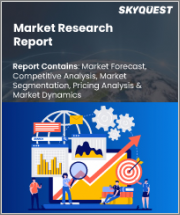
|
시장보고서
상품코드
1740874
인산철리튬 시장 기회, 성장 촉진요인, 산업 동향 분석 및 예측(2025-2034년)Lithium Iron Phosphate Market Opportunity, Growth Drivers, Industry Trend Analysis, and Forecast 2025 - 2034 |
||||||
세계의 인산철리튬 시장은 2024년에는 26억 달러로 평가되었으며 CAGR 20.8%를 나타내 2034년에는 167억 달러에 이를 것으로 추정됩니다.
이 두드러진 성장 궤도는 높은 열 안정성, 수명주기 연장 및 기타 양극 재료에서 일반적으로 사용되지만 비용이 많이 드는 공급망의 복잡성을 수반하는 코발트를 사용하지 않는 재료의 유리한 특성으로 인해 크게 지원됩니다. 이 시스템은 장기적인 지속가능성과 효율적인 에너지 보존에 적합하기 때문에 니켈 기반의 정극기술에 비해 LFP는 보다 안정적인 공급라인을 제공할 뿐만 아니라 대폭 저비용이기 때문에 대규모로 수요가 많은 용도에 실용적인 선택이 되고 있습니다.

LFP의 경제적 매력은 재활용 및 이차 전지 용도에서의 성능에 의해 더욱 증폭되어 생태와 상업의 관점에서 유리한 선택이 되고 있습니다. 재료 재사용과 재활용 능력이 재료 선택의 매우 중요한 요소가 되고 있습니다. 독립 재생 가능 프로젝트에 있어서의 LFP의 신뢰성과 효율성은 전력 저장 인프라에 있어서의 새로운 벤치마크가 되고 있습니다. 외국산 원료에 대한 의존도를 줄이기 위해 지역 밀착형 공급망을 우선하고 있습니다.
| 시장 범위 | |
|---|---|
| 시작 연도 | 2024년 |
| 예측 연도 | 2025-2034년 |
| 시작 금액 | 26억 달러 |
| 예측 금액 | 167억 달러 |
| CAGR | 20.8% |
2024년, LFP 시장은 형태별로 과립, 분말, 현탁액/분산액으로 구분되었습니다. 분말은 시장 전체의 71.8%를 차지해, 이 분야를 리드했습니다. 미세한 입자경은 뛰어난 전도성을 가능하게 하고 요구가 엄격한 이용 사례에 있어서 성능과 효율을 향상시킵니다.
과립은 특히 내구성과 높은 내열성을 필요로 하는 용도로 다양한 산업에서 사용되고 있습니다. 한편, 현탁액이나 분산액의 형태는 열 안정성이나 기계적 강도를 향상시키는 범용성이 있기 때문에 기세를 늘리고 있습니다.
용도별로는 2024년에는 배터리 분야가 86.5% 시장 점유율을 차지해 우위를 점했습니다. 비용 효율적이고 안전한 에너지 솔루션을 선호하며, 그 특성은 LFP의 능력과 잘 어울립니다.
전동 이동성으로의 변화는 LFP 수요에 계속 영향을 미칩니다. 배터리 전기자동차 시장에서도 2025년까지 4,969억 달러의 수익이 예상되며, 2025년부터 2029년까지의 연간 성장률은 8.46%를 나타낼 것으로 예상됩니다. 2029년에는 이 시장이 6,877억 달러에 달할 것으로 예측됩니다.
배터리 시스템 외에도 LFP는 특수한 재료나 공업 제조에도 채용되고 있습니다. 화학 및 고분자 제조 분야에서의 촉매 사용은 환경에 미치는 영향을 줄이면서 생산 효율을 높이고 있습니다.
미국은 2024년 세계 인산철리튬 시장의 16.5%를 차지했으며, 4억 3,000만 달러에 달했습니다. 정부의 강력한 지원, 전기자동차 판매 급증, 국내 전지 제조능력 확대로 인한 것입니다.
시장의 경쟁력학은 다수의 유력 기업에 의해 형성되어 있으며, 각각이 발판을 굳히기 위해 다른 전략을 추구하고 있습니다.
목차
제1장 조사 방법과 범위
제2장 주요 요약
제3장 업계 인사이트
- 생태계 분석
- 밸류체인에 영향을 주는 요인
- 이익률 분석
- 파괴적 혁신
- 향후 전망
- 제조업체
- 유통업체
- 공급자의 상황
- 이익률 분석
- 주요 뉴스와 대처
- 규제 상황
- 영향요인
- 성장 촉진요인
- EV 배터리 수요 급증
- 에너지 저장 시스템(ESS)의 확장
- 니켈 기반의 캐소드보다 높은 비용 효율
- 리사이클과 세컨드 라이프의 용도
- LFP 처리에 있어서의 기술적 진보
- 상업 및 산업용 스토리지 수요 증가
- 업계의 잠재적 위험 및 과제
- 원재료 공급의 제약
- 한정된 배터리 이외의 산업용도
- 고체 및 나트륨 이온의 대체품의 출현
- 성장 촉진요인
- 성장 가능성 분석
- Porter's Five Forces 분석
- PESTEL 분석
제4장 경쟁 구도
- 서론
- 기업의 시장 점유율 분석
- 경쟁 포지셔닝 매트릭스
- 전략적 전망 매트릭스
제5장 시장 추계·예측 : 형태별(2021-2034년)
- 주요 동향
- 파우더
- 과립
- 현탁액/분산액
제6장 시장 추계·예측 : 용도별(2021-2034년)
- 주요 동향
- 배터리
- 유리 및 세라믹
- 촉매
- 코팅 및 안료
- 기타
제7장 시장 추계·예측 : 지역별(2021-2034년)
- 주요 동향
- 북미
- 미국
- 캐나다
- 유럽
- 독일
- 영국
- 프랑스
- 스페인
- 이탈리아
- 러시아
- 아시아태평양
- 중국
- 인도
- 일본
- 호주
- 한국
- 라틴아메리카
- 브라질
- 멕시코
- 중동 및 아프리카
- 사우디아라비아
- 남아프리카
- 아랍에미리트(UAE)
제8장 기업 프로파일
- Aleees(Advanced Lithium Electrochemistry Co.Ltd.)
- BASF SE
- Formosa Lithium Iron Oxide Corporation
- Gotion High-Tech Co.Ltd.
- Himadri Speciality Chemical Ltd
- Hunan Yuneng
- Innophos
- Livium
- MSE Supplies LLC
- MTI Corporation
- Nano One Materials Corp.
- NEI Corporation
- Targray
The Global Lithium Iron Phosphate Market was valued at USD 2.6 billion in 2024 and is estimated to grow at a CAGR of 20.8% to reach USD 16.7 billion by 2034. This remarkable growth trajectory is largely supported by the material's advantageous characteristics such as high thermal stability, extended lifecycle, and the absence of cobalt-an element commonly used in other cathode materials but often associated with higher costs and supply chain complexities. The increasing reliance on renewable energy has accelerated the adoption of LFP-based storage solutions, as these systems are more suited for long-term sustainability and efficient energy retention. Compared to nickel-based cathode technologies, LFP not only offers a more stable supply line but also comes at a significantly lower cost, making it a practical choice for large-scale and high-demand applications.

The economic appeal of LFP is further amplified by its performance in recycling and second-life battery applications, making it a favorable option from both an ecological and commercial standpoint. As industries and governments push toward greener energy solutions, the ability to reuse and recycle materials becomes a pivotal factor in material selection. The growing demand for commercial and industrial energy storage solutions has also emerged as a major factor fueling the market expansion. LFP's reliability and efficiency in large-scale backup systems, grid-connected storage, and independent renewable projects are setting new benchmarks in power storage infrastructure. In addition to technological advantages, policy support plays a critical role. Governments are actively rolling out financial incentives and subsidies while prioritizing localized supply chains to reduce dependence on foreign raw materials. Strategic moves across regions including North America, Asia-Pacific, and Europe continue to expand the global reach of LFP materials.
| Market Scope | |
|---|---|
| Start Year | 2024 |
| Forecast Year | 2025-2034 |
| Start Value | $2.6 Billion |
| Forecast Value | $16.7 Billion |
| CAGR | 20.8% |
In 2024, the LFP market by form was segmented into granules, powder, and suspension/dispersion. The powder form led the segment, accounting for 71.8% of the total market. This dominance is driven by the powder's widespread use in lithium-ion batteries across electric vehicles, electronics, and energy storage applications. The fine particle size enables excellent electrical conductivity, which improves performance and efficiency in demanding use cases. Advanced developments such as nanostructured coatings are also boosting powder-based LFP demand by enhancing energy density and battery lifespan.
Granules are used across several industries, particularly in applications requiring durability and high thermal resistance. They are commonly integrated into industrial materials, offering structural and performance benefits. The granule form is especially valued in sectors requiring resilient material composition for use in high-temperature environments. Meanwhile, the suspension and dispersion form is gaining momentum due to its versatility in enhancing thermal stability and mechanical strength. This form is seeing growing usage in specialized industrial coatings and conductive inks that require consistent performance in extreme conditions.
In terms of application, the battery segment dominated in 2024, holding a market share of 86.5%. The overwhelming demand for batteries is driven by surging interest in electric vehicles and grid-scale energy storage systems. Customers are prioritizing long-lasting, cost-efficient, and safe energy solutions-characteristics that align well with LFP's capabilities. Its cycle life and thermal safety give it a clear advantage in sectors where energy reliability and longevity are critical.
The increasing shift toward electric mobility continues to influence LFP demand. The Battery Electric Vehicles market alone is projected to generate USD 496.9 billion in revenue by 2025, with an expected annual growth rate of 8.46% from 2025 to 2029. By 2029, this market is projected to reach USD 687.7 billion. As electric vehicles become more mainstream, LFP's role as a preferred cathode material will continue to solidify.
Beyond battery systems, LFP is also being adopted for use in specialized materials and industrial manufacturing. The push for durable and heat-resistant materials in electronics and infrastructure is encouraging further adoption. Its usage in catalysts within chemical and polymer production sectors continues to enhance manufacturing efficiency while reducing environmental impact. The growing demand for sustainable manufacturing practices is reinforcing the material's relevance across non-energy domains as well.
The United States accounted for 16.5% of the global lithium iron phosphate market in 2024, translating to USD 430 million. This figure is forecasted to rise to USD 2.86 billion by 2034. The region is experiencing rapid growth due to robust federal support for clean energy initiatives, a strong surge in electric vehicle sales, and the expansion of domestic battery manufacturing capabilities. These factors are contributing to North America's accelerated adoption of LFP technology. The presence of supportive government policies and well-aligned sustainability goals continues to propel market momentum in the region.
The competitive dynamics of the market are shaped by several prominent players, each pursuing different strategies to strengthen their foothold. Industry leaders are leveraging innovation, partnerships, and localized production to meet the growing global demand for lithium iron phosphate materials.
Table of Contents
Chapter 1 Methodology & Scope
- 1.1 Market scope & definition
- 1.2 Base estimates & calculations
- 1.3 Forecast calculation
- 1.4 Data sources
- 1.4.1 Primary
- 1.4.2 Secondary
- 1.4.2.1 Paid sources
- 1.4.2.2 Public sources
- 1.5 Primary research and validation
- 1.5.1 Primary sources
- 1.5.2 Data mining sources
Chapter 2 Executive Summary
- 2.1 Industry synopsis, 2021 - 2034
Chapter 3 Industry Insights
- 3.1 Industry ecosystem analysis
- 3.1.1 Factor affecting the value chain
- 3.1.2 Profit margin analysis
- 3.1.3 Disruptions
- 3.1.4 Future outlook
- 3.1.5 Manufacturers
- 3.1.6 Distributors
- 3.2 Supplier landscape
- 3.3 Profit margin analysis
- 3.4 Key news & initiatives
- 3.5 Regulatory landscape
- 3.6 Impact forces
- 3.6.1 Growth drivers
- 3.6.1.1 Surging demand for EV batteries
- 3.6.1.2 Expansion of energy storage systems (ESS)
- 3.6.1.3 Cost-effectiveness over nickel-based cathodes
- 3.6.1.4 Recycling & second-life applications
- 3.6.1.5 Technological advancements in LFP processing
- 3.6.1.6 Rising demand for commercial & industrial storage
- 3.6.2 Industry pitfalls & challenges
- 3.6.2.1 Raw material supply constraints
- 3.6.2.2 Limited industrial applications beyond batteries
- 3.6.2.3 Emerging solid-state & sodium-ion alternatives
- 3.6.1 Growth drivers
- 3.7 Growth potential analysis
- 3.8 Porter's analysis
- 3.9 PESTEL analysis
Chapter 4 Competitive Landscape, 2024
- 4.1 Introduction
- 4.2 Company market share analysis
- 4.3 Competitive positioning matrix
- 4.4 Strategic outlook matrix
Chapter 5 Market Estimates and Forecast, By Form, 2021 - 2034 (USD Billion) (Kilo Tons)
- 5.1 Key trends
- 5.2 Powder
- 5.3 Granules
- 5.4 Suspension/dispersion
Chapter 6 Market Estimates and Forecast, By Application, 2021 - 2034 (USD Billion) (Kilo Tons)
- 6.1 Key trends
- 6.2 Battery
- 6.3 Glass & ceramics
- 6.4 Catalysts
- 6.5 Coatings & pigments
- 6.6 Others
Chapter 7 Market Estimates and Forecast, By Region, 2021 - 2034 (USD Billion) (Kilo Tons)
- 7.1 Key trends
- 7.2 North America
- 7.2.1 U.S.
- 7.2.2 Canada
- 7.3 Europe
- 7.3.1 Germany
- 7.3.2 UK
- 7.3.3 France
- 7.3.4 Spain
- 7.3.5 Italy
- 7.3.6 Russia
- 7.4 Asia Pacific
- 7.4.1 China
- 7.4.2 India
- 7.4.3 Japan
- 7.4.4 Australia
- 7.4.5 South Korea
- 7.5 Latin America
- 7.5.1 Brazil
- 7.5.2 Mexico
- 7.6 Middle East and Africa
- 7.6.1 Saudi Arabia
- 7.6.2 South Africa
- 7.6.3 UAE
Chapter 8 Company Profiles
- 8.1 Aleees (Advanced Lithium Electrochemistry Co., Ltd.)
- 8.2 BASF SE
- 8.3 Formosa Lithium Iron Oxide Corporation
- 8.4 Gotion High-Tech Co., Ltd.
- 8.5 Himadri Speciality Chemical Ltd
- 8.6 Hunan Yuneng
- 8.7 Innophos
- 8.8 Livium
- 8.9 MSE Supplies LLC
- 8.10 MTI Corporation
- 8.11 Nano One Materials Corp.
- 8.12 NEI Corporation
- 8.13 Targray



















